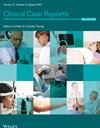下颌骨特发性骨腔的诊断与治疗1例
IF 0.6
Q3 MEDICINE, GENERAL & INTERNAL
引用次数: 0
摘要
下颌骨的特发性骨腔通常可以在x线检查中发现。如果发现,医生应每3-6个月随访一次,只有当病变变大或出现症状时才考虑手术干预。本文章由计算机程序翻译,如有差异,请以英文原文为准。

Diagnosis and Treatment of Idiopathic Bone Cavity in the Mandible: A Case Report
Idiopathic bone cavity of the mandible can often be identified in a radiographic exam. If detected, physicians should conduct follow-up every 3–6 months, with surgical intervention considered only if the lesion becomes large or symptomatic.
求助全文
通过发布文献求助,成功后即可免费获取论文全文。
去求助
来源期刊

Clinical Case Reports
MEDICINE, GENERAL & INTERNAL-
自引率
14.30%
发文量
1268
审稿时长
13 weeks
期刊介绍:
Clinical Case Reports is different from other case report journals. Our aim is to directly improve global health and increase clinical understanding using case reports to convey important best practice information. We welcome case reports from all areas of Medicine, Nursing, Dentistry, and Veterinary Science and may include: -Any clinical case or procedure which illustrates an important best practice teaching message -Any clinical case or procedure which illustrates the appropriate use of an important clinical guideline or systematic review. As well as: -The management of novel or very uncommon diseases -A common disease presenting in an uncommon way -An uncommon disease masquerading as something more common -Cases which expand understanding of disease pathogenesis -Cases where the teaching point is based on an error -Cases which allow us to re-think established medical lore -Unreported adverse effects of interventions (drug, procedural, or other).
 求助内容:
求助内容: 应助结果提醒方式:
应助结果提醒方式:


